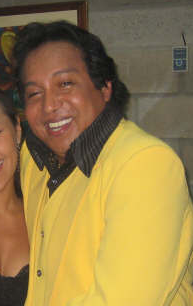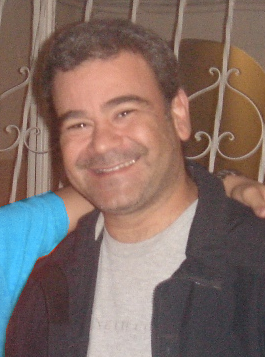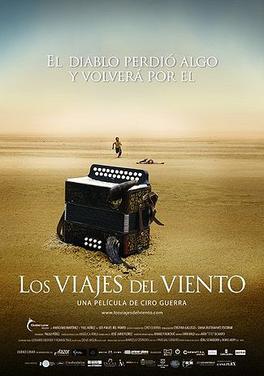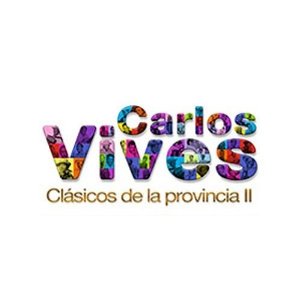Related Research Articles

The music of Colombia is an expression of Colombian culture, music genres, both traditional and modern, according with the features of each geographic region, although it is not uncommon to find different musical styles in the same region. The diversity in musical expressions found in Colombia can be seen as the result of a mixture of Amerindian, African, and European influences, as well as more modern American.

Valledupar is a city and municipality in northeastern Colombia. It is the capital of Cesar Department. Its name, Valle de Upar, was established in honor of the Amerindian cacique who ruled the valley; Cacique Upar. The city lies between the mountains of the Sierra Nevada de Santa Marta and the Serranía del Perijá to the borders of the Guatapurí and Cesar rivers.

Vallenato is a popular folk music genre from Colombia. It primarily comes from its Caribbean region. Vallenato literally means "born in the valley". The valley influencing this name is located between the Sierra Nevada de Santa Marta and the Serranía de Perijá in north-east Colombia. The name also applies to the people from the city where this genre originated: Valledupar. In 2006, vallenato and cumbia were added as a category in the Latin Grammy Awards. Colombia's traditional vallenato music is Intangible Cultural Heritage in Need of Urgent Safeguarding, according to UNESCO.

The carnival in Colombia was introduced by the Spaniards. The Colombian carnival has incorporated elements from European culture, and has managed to syncretise, or re-interpret, traditions that belonged to the African and Amerindian cultures of Colombia. There is documentary evidence that the carnival existed in Colombia in the 17th century and had already caused concern to the colonial authorities, who censored the celebrations, especially in the main centers of power such as Cartagena, Bogotá and Popayán. The carnival, therefore, continued its evolution and re-interpretation in the small and at that time unimportant towns where celebrations did not offend the ruling elites. The result was the uninterrupted celebration of carnival festivals in Barranquilla, and other villages along the lower Magdalena River in northern Colombia, and in Pasto, Nariño in the south of the country. In modern times, there have been attempts to introduce the carnival in the capital, Bogotá, in the early 20th century, but it has always failed to gain the approval of authorities. The Bogotá Carnival has had to wait until the 21st century to be resurrected, this time, by the authorities of the city. Colombia is recognized by its large variety of festivals, carnivals and fairs. Most towns have their own, ranging from those celebrating coffee to the ones held in honor of the town's Saint feast. The common characteristics of the festivals are the nomination of a beauty Queen and the setting up of public dance floor.

The Vallenato Legend Festival is one of the most important musical festivals in Colombia. The festival features a vallenato music contests for best performer of accordion, caja vallenata and guacharaca, as well as piqueria and best song. It's celebrated every year in April in the city of Valledupar, Department of Cesar.

Diomedes Díaz Maestre was a Colombian vallenato singer, songwriter, and composer. He has been named the "King of Vallenato" and is nicknamed El Cacique de La Junta, which was given to him by another vallenato singer, Rafael Orozco Maestre, in honor of Díaz's birthplace.
Consuelo Inés Araújo Noguera, also known as "La Cacica", was a Colombian politician, writer and self-taught journalist. Her nickname was given by a fellow journalist colleague for her tenacity and determination to achieve goals and leadership.
Nicolas Elias Mendoza Daza, also known as Colacho Mendoza, was a Colombian Vallenato accordion player and was crowned king of accordion players on many occasions in the Vallenato Legend Festival. He was born in a small village called Sabanas de Manuela in the municipality of Barrancas, La Guajira Department, in northern Colombia.

Iván Francisco Villazón Aponte, is one of the most renowned vallenato singers in Colombia. His career as a singer began in 1984 after dropping out of college where he was pursuing a degree in law.

Jorge Antonio Oñate González was a Colombian singer and composer, one of the most renowned of the vallenato musical genre. As of 2004 and since the beginning of his career in 1968 he had achieved 25 gold discs, 7 platinum discs and 6 double platinum for his sales, among other numerous musical accomplishments. He had also successfully entered politics as councilor of his hometown, while deputising for Alfredo Cuello Dávila, representing the department of Cesar.

Silvestre Francisco Dangond Corrales is a Colombian singer. He attributes his talents to his father, the singer William José "El Palomo" Dangond Baquero, who during the mid-1970s recorded 10 singles with Andrés "El Turco" Gil; and his mother, who comes from a musical family and passed down her charismatic nature to him, while also playing a major role in his formal and personal education.

Juan Mario De la Espriella better known as Juancho De la Espriella is a Colombian musician interpreter of vallenato in accordion. De la Espriella is the current accordionist of Colombian vallenato singer Martin Elias Diaz.
Leandro José Díaz Duarte was a Colombian vallenato music composer. He is mostly known for his ability to compose very descriptive and narrative vallenato songs despite his blindness. His songs have been recorded by many Colombian musicians including Carlos Vives, Diomedes Diaz, Jorge Oñate, Ivan Villazon, among others.

The Wind Journeys is a 2009 Colombian-German-Argentine-Dutch drama film written and directed by Ciro Guerra. It was filmed in 80 locations in Northern Colombia and is spoken in Spanish, Palenquero, Wayuunaiki, and Ikun. It was selected as the Colombian entry for the Best Foreign Language Film at the 82nd Academy Awards, but was not nominated.

Celso Piña Arvizu was a Mexican singer, composer and accordionist, mainly in the genre of cumbia, being one of the most important musicians in the style of "cumbia rebajada".

Alfredo de Jesús Gutiérrez Vital is a Colombian accordion player and singer famous for winning the "Vallenato Legend Festival" three times.

Lágrimas Cálidas is the debut studio album by Colombian recording artist Fanny Lu, released on August 8, 2006. The record contains ten tracks, most of which were composed by Jose Gaviria, and produced with Andres Munera. Musically, the album experiments with tropipop, which is composed of the genres of vallenato, merengue, and pop music. Recording for the album took place in 2004 in three cities: Miami, Bogota and Medellin. An international version of the album, containing two remixes, was released exclusively in United States, Spain and Colombia.

Clásicos de la Provincia II is the twelfth album by Colombian singer/composer Carlos Vives. The album is a sequel to Vives' 1993 breakthrough album Clásicos de la Provincia and like its predecessor it is a collection of vallenato standards, updated by Carlos and his long-time backing band La Provincia.
Andrés Gregorio Guerra Landero was a Colombian musician and composer. He was known as "The King of Cumbia".
References
- ↑ "Francisco, el Hombre". Ao Sul do Mundo. Retrieved 2019-09-12.
- 1 2 3 4 Casalins Pérez, Alexander; Sánchez Contreras, César Augusto; Vergara Serpa, Berena (September 2014). Francisco El Hombre: Juglar y Leyenda (PDF). Cartagena de Indias: Ministerio de Cultura. ISBN 978-958-58950-3-4 . Retrieved May 25, 2016.
- ↑ "Mitos y leyendas: La leyenda de Francisco "el hombre"". Festival de la Leyenda Vallenata. Archived from the original on June 22, 2014. Retrieved February 25, 2017.